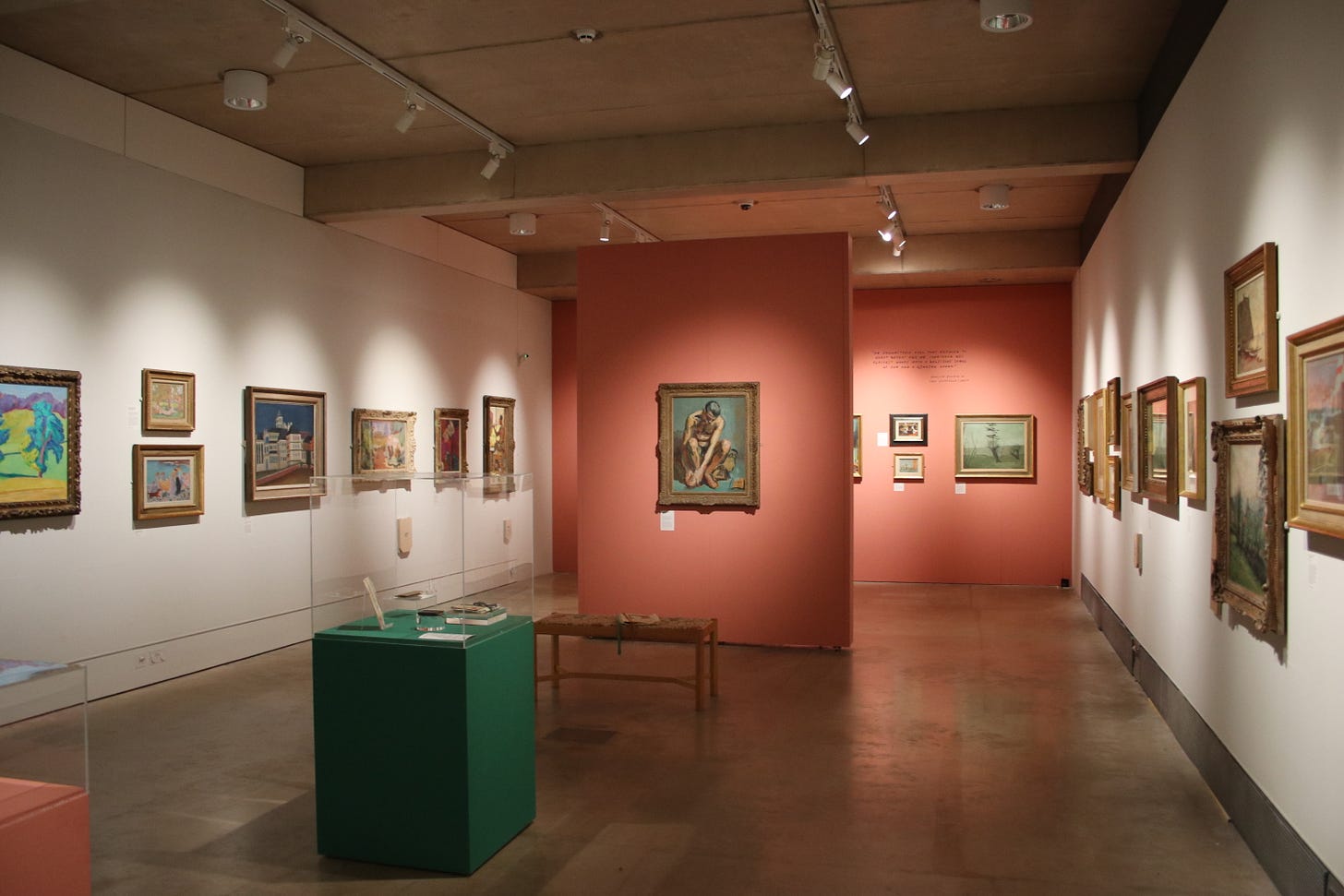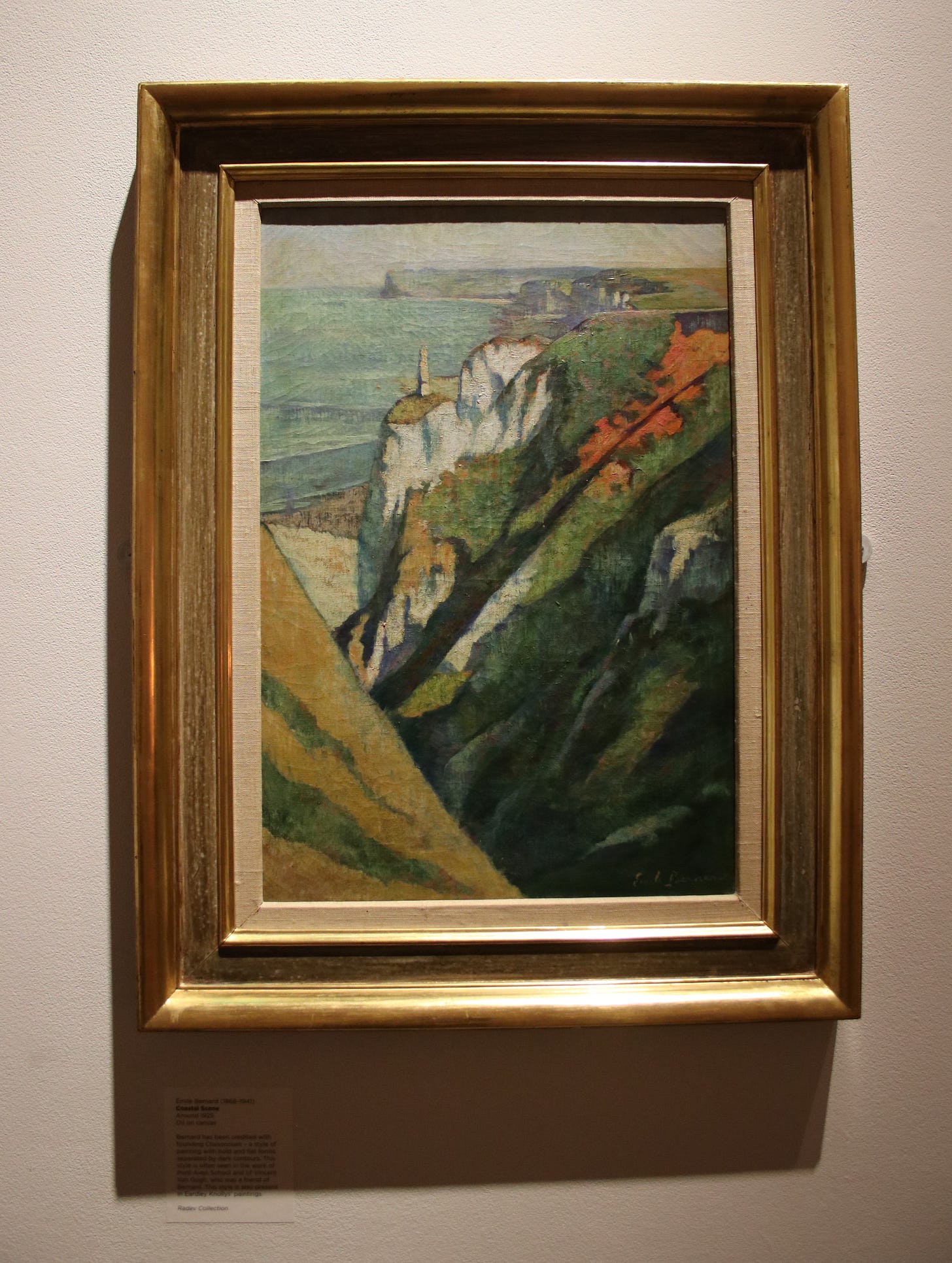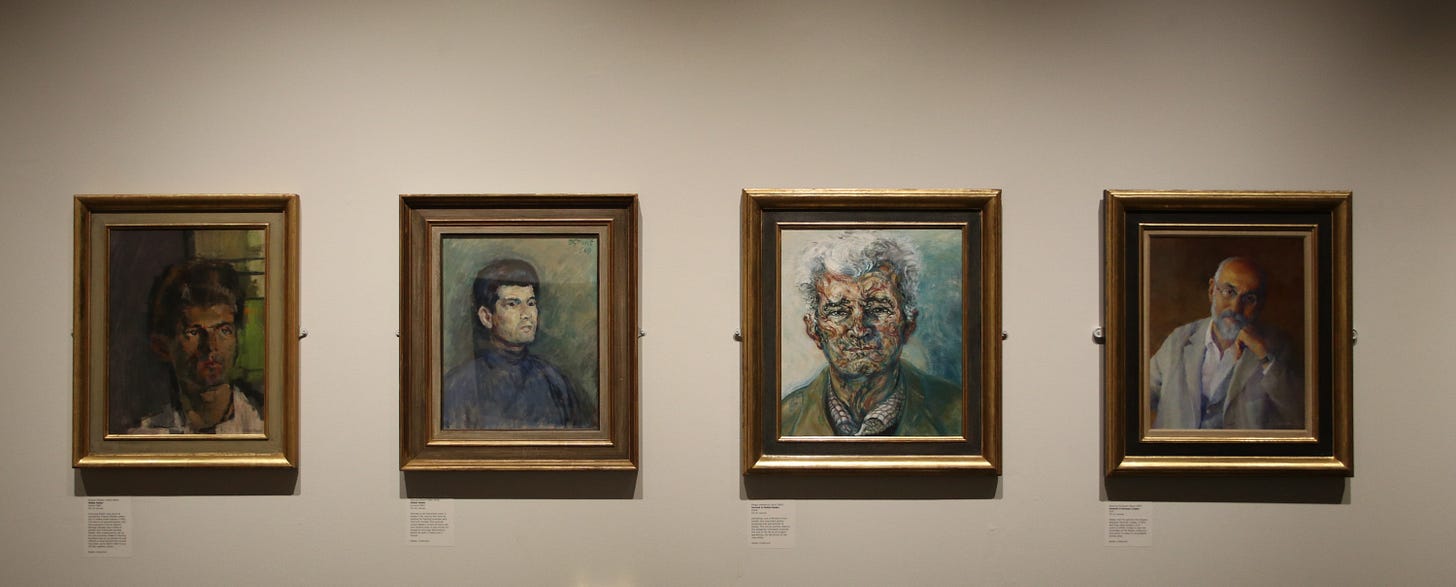The pleasure of private treasures
Viewing minor masterpieces produced by a kaleidoscope of major artists, prompted thoughts about patrons and the power of pleasure.
[The Radev Collection, installation view]
Walking past the vibrant Modern pictures in the Radev Collection (The Wilson Art Gallery, Cheltenham, closes 1 September 2024) comprises of pictures on view are from an 800-picture collection that is amalgamated from several earlier collections. This gives the display a curiously historical quality – something like a catalogue provenance listing – which highlights the stories of the pictures and the collectors who bought them.
The list of artists is a roll call of British Modernism: Duncan Grant, Augustus John, Ben Nicholson, Christopher Wood, Alfred Wallis, Matthew Smith, Paul Nash, John Piper, Graham Sutherland, Ivon Hitchens, Keith Vaughan and others. The notable foreign artists are Eugène Boudin, Braque, Picasso and Gaudier-Brzeska. A large pleasing (undated) portrait drawing of Soutine is by Modigliani, perhaps the single most outstanding work in the collection.
[Émile Bernard, Coastal Scene (1925), oil on canvas]
Émile Bernard is represented by a wonderful vertically-oriented landscape from around 1925, which disproves my assumptions about him being a crude painter driven by the imperative to create pictures of flat planes and emphatic shapes. This landscape shows he can endow a painting with subtlety born of observation and care. Stand-out works by British artists are three gouaches by Sutherland. A scene of a bombed building is another painting that slipped past the War Ministry’s ownership of Sutherland’s work as a war artist. The use of red and yellow in Pembrokeshire (1940) is bold, as are the organic forms inspired by bones, stones, roots and weathered wood.
Mattei Radev (1927-2009) was an illegal immigrant to England, who fled Communist Bulgaria in 1950. He worked at Whittington Hospital, London as a porter, where a friendship with surgeon Patrick Trevor Roper would lead to him meeting E.M. Forster, Edward Sackville-West and Robert Medley. Following his acceptance into the Bloomsbury circle, Radev gained an appreciation of art. He would later go on to become a picture framer. His collection would be augmented through inheritance of the collection of Edward Eardley Knollys, who inherited it from Sackville-West in 1965. Knollys and Frank Coombs ran the Storran Gallery in London from 1936 to 1944, Eardley Knollys running the gallery solely after Coombs’s death in the bombing of Belfast in 1941. Eardley Knollys was involved in the National Trust and the early years of the Contemporary Art Society; he would meet Radev in 1957. Upon his death in 1991, he bequeathed his collection to Radev.
[Portraits of Radev]
The subsequent collection of art (and presumably publications, books and correspondence, not presented here) follows the trajectory Modernism in Great Britain from the Impressionism of L. Pissarro, through to the Post-Impressionism of Bernard, the Folk Art of Wallis, the faux naïf style of Wood, then the Bloomsbury Group and later the Unit One semi-abstraction and the Neo-Romanticism of Sutherland and Piper. It is a dizzying tour of the greats, leaving the imprint of the taste of the collectors. Knollys collected mainly French works, Sackville-West Modern British; Radev bought pictures by later British artists whom he knew. Included are some portraits of Radev by artists including Maggi Hambling.
The pieces themselves are modest in scope and domestic in scale but that is no bad thing. Piper made a multi-sheet lithograph is a panorama made for a nursery – a worthy medium for an affordable decorative scheme. A few less familiar names are welcome. A still-life by Adrian Ryan (1920-1998) Fish (1960) has vivid but restrained colour and an energetic handling that leave one keen to know more of him. Edward Wolfe has an African head (impassive and faceted) that exists midway between portrait and mask. There are some paintings by Knollys himself that show good command of Fauvist and Post-Impressionist technique – a country view with foliage painted in pungent aqua, turquoise and lemon yellow is especially eye catching.
The art in the collection shows artists reinventing traditional subjects in new forms. The artists were not unknowns when they were bought, but definitely affordable for collectors who (despite being upper class) were not super wealthy. The nature of the art market and the distribution of wealth worldwide means that to buy blue-chip art, collectors today compete with collectors worldwide in a way that they did not have to in the immediate post-war period. It is also a factor that taste has changed. Many upper-class collectors of the time were being to decorate their homes and often had very conservative tastes and so were not buying such pictures, which kept prices high but affordable for Modern pictures. In short, the Radev Collection comprises the endeavours of both artists and collectors who had faith in themselves, could extend tradition without relying on moribund idioms and took huge pleasure in art.
Most of the art here is beautiful, delicious and satisfying and any that is not fails only by virtue of lapses of artist’s ability or collector’s eye. What stands out is an absence of the Geometry of Fear, Baconian existentialism, pure abstraction and the more challenging variants of Surrealism. It is clear that these collectors bought for pleasure rather than in any sort of systematic attempt to capture a cross-section of the art world in the post-war period. Now, in a museum we might deplore these omissions but in a private collection (compound or sole collector) these are no longer omissions but an active expression of positive taste. Indeed, freed from the duty to be distant and even handed, the collections can take on the most exciting and pleasure-giving form of collecting: the private collection bought contemplation at home, chosen purely according to personal taste. It is an aspiration for artists and art appreciators to have such active and discriminating collectors supporting art that they cherish and preserve for its own sake.
The Radev Collection shows what individuals can do with foresight, co-operation and only a modest amount of money to spend on art. Keeping the collections together and passing them on to sympathetic associates can build collections of important works, capture the essentials of a period and protect them from the predation and indifference of a public ownership in the hands of those hostile to its principles. However, it is only when later generations adhere to the essence of the original collectors that a legacy can be maintained. In that sense, patrimony of an art collection is like the compact between generations of a nation. If later generations cannot see the purpose of a compact, then it will fail, either organically through neglect or through hostile action to destroy it. In that respect this exhibition and collection should be of great interest to those intent on building an ambitious living culture independent of museums.
The history, the fate and model of such a collection should inspire all of us who love art and wish to see it flourish.






Thank you - this is a must-see.
Although when I click on the museum's page:
"Told through the stories of the three collectors and the homes the collection grew around, this exhibition explores a remarkable time queer history and the history of British art."
Luckily it's easy to rise above such things when the art is of this quality.
What a beautiful collection of paintings. Thank you so much for sharing it with us. It’s sad that collecting art has come to be seen as a privilege exclusive to the rich. My own grandparents owned a piece by George W. Morrison, a very minor, self-taught Ulster painter - he’d previously been a cricketer. They saw a display of his work at a department store in Belfast called Anderson & McAuley’s, in the 1960’s, and just bought one. Its provenance is the time it spent on my grandparents’ wall, which is pretty special to us.